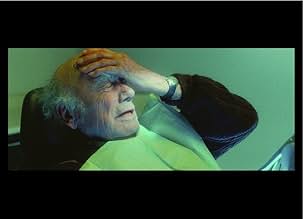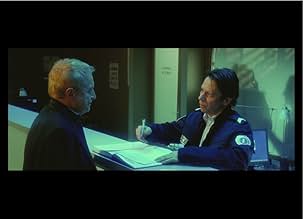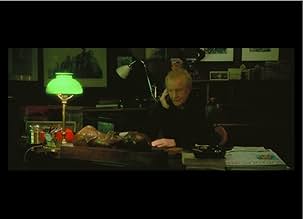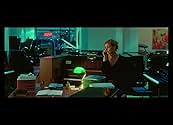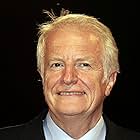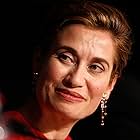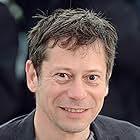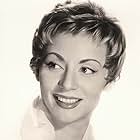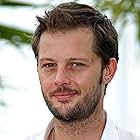A quirky woman who spends her free time as a pilot has her purse stolen; when a mysterious man finds her wallet, they embark on a peculiar romance.A quirky woman who spends her free time as a pilot has her purse stolen; when a mysterious man finds her wallet, they embark on a peculiar romance.A quirky woman who spends her free time as a pilot has her purse stolen; when a mysterious man finds her wallet, they embark on a peculiar romance.
- Awards
- 3 wins & 14 nominations
Michel Vuillermoz
- Lucien d'Orange
- (as Michel Vuillermoz de la Comédie Française)
Edouard Baer
- Le narrateur
- (voice)
Stéfan Godin
- Acolyte aviation
- (as Stefan Godin)
Roger Pierre
- Marcel Schwer
- (as Roger-Pierre)
- Director
- Writers
- All cast & crew
- Production, box office & more at IMDbPro
Storyline
Did you know
- TriviaThe Spitire is a Supermarine Spitfire PR Mk XIX, number PS 890, built in 1945. It is owned by a French collector (as of 2016) and has the French registration code, F-AZJS. Since the film was made, it has been restored to its wartime colours of RAF 152 (Hyderabad) Squadron (which served in South East Asia)
- Crazy creditsThe credits show considerable variation in their presentation. The first credits seen are the individual actor names with the name of the character played, in a serif font, with shadowed letters. These credits are moving left to right across the screen, fading in and out at different points, over a background of the film's name in larger letters, in an italicized serf font. After the first ten actors, there is abrupt change to a sans serif font, again with shadowed text, for both the cast/ characters list and the film title. The film title is now angled up to the right and is not in clear focus. After the names of the cast, the credits start as scrolling white text on a black background using a serif font, then there is a change to a sans serif font and then a return to the serif font. The next change is to black text on a grey background using a serif font. This then reverts to white text on a black background with a serif font, then a change to a sans serif font and then a return to the serif font. These credits do not stay in a central position, but move from side to side on the screen.
- ConnectionsFeatured in At the Movies: Cannes Film Festival 2009 (2009)
- SoundtracksSalue la Lune
Written by Allan Gray and Walter Reisch
Performed by Marguerite's acolytes at the aerodrome
Featured review
The 87-year-old French New Wave veteran directs his longtime star and companion Sabine Azéma (27 years his junior) and regular co-star André Dusollier in this adaptation of an idiosyncratic novel by Christian Gailly about a man and a woman who become fascinated with each other when the man finds the woman's stolen wallet.
The essence of the piece is that the principals are hesitant, indecisive, and a mite crazy. Their experience is the kind that falls through the cracks of well-ordered existence. Hence the new title replacing Gailly's "The Incident," to "Les herbes folles," "crazy grasses." There's a recurrent image of wild grass growing high among stones.
The comfy suburban house of Georges (Dusollier) feels rather like that of Jean-Louis Trintignant outside Geneva, and like Kieslowski's 'Red,' this film is about trying to connect, and has a protagonist who's both respectable and an outlaw. Georges is paranoid about being recognized by police, as if he's done something wrong or been in jail. Yet he has two charming grown children (Sara Forestier, Vladimir Consigny), and a loving and equally appealing wife, Susanne (Anne Consigny, familiar to US French film fans from Schnabel's 'Diving Bell' and Desplechin's 'Christmas Tale'). Georges never acquires a full back-story, but Dusollier is brilliant at depicting his mercurial temperament, and a continual pleasure to watch, as is the equally live-wire Azéma.
Marguerite Muir (Azéma) is a dentist who shares an office with the offbeat French film diva Emmanuelle Devos. Another big French film actor, Matthieu Amalric, plays the cop in the station to whom Georges delivers the found wallet. Strong newcomer Nicolas Duvauchelle, a former boxer, plays Georges' daughter's boyfriend, and he invites Georges to come watch him fight, as well as to use the familiar "tu" with him, but Georges doesn't do either.
Muir has put off till tomorrow reporting the purse-snatching that happened after she bought an expensive pair of shoes. Georges looks up Marguerite and has her phone number and address, but can't bring himself to call her. Georges and Marguerite wind up stalking each other, and the police become involved to call Georges off.
One can see how this could be a quirky, amusing novel, and the innumerable missteps, oversteps, and hesitations would work well verbally. This kind of convoluted mental quirkiness is hard to translate, which is why idiosyncratic literary masterpieces like Sterne's Tristram Shandy have defied the impulse to adapt them cinematically, though Michael Winterbottom made a sporting try (shown in the 2005 NYFF and reviewed by me here). Resnais' task is to find a visual equivalent. The highly mobile camera of Eric Gautier is a considerable asset. On the other hand the jazzy music of Hollywood composer Mark Snow is sometimes merely obtrusive, as at a family gathering where the sax pointlessly overwhelms the scene. But on the other hand it's warm and enveloping in an old-fashioned way in the opening sequences when the two main characters are introduced and we're meant to be charmed and drawn in, and we are.
Resnais and Gailly did not collaborate, at Gaillys' request; he wanted to be left alone to work on his next novel. One of the ways Resnais portrays confused intentions is to show cameos of imagined actions in frames where the character is doing something else; and another is that most obvious interjection of the literary into the cinematic, the use of frequent voice-overs. The production is expensive for a French art film, involving fairly lavish sets and scenes involving small airplanes. One of the links between Georges is that his father wanted to be a pilot and he loves aviation, while Marguerite actually has a pilot's license.
Though Assistant Director Christophe Jeauffroy may have done a lot of the work for the aging master, there are many of the latter's familiar touches, including a lot of rapid cutting early on that recalls his 1963 'Muriel ou Le temps d'un retour.' A director but not a writer whose early fame was due to adaptations of Marguerite Duras ('Hiroshima mon amour') and Alain Robbe-Grillet ('Last Year at Marienbad'), which represent totally opposed sensibilities, Resnais here tries on yet another one. The result is far more conventional than those Sixties films, and on the glossy and mainstream side, veering between farce and melodrama. 'Wild Grass' is full of assurance, and engages from the start. It may disappoint viewers in search of something more profound, more meditative, or funnier, but it's still a work of considerable accomplishment and doubtless may reward repeat viewings by devotees.
Show as an official selection of the NYFF 2009 at Lincoln Center.
The essence of the piece is that the principals are hesitant, indecisive, and a mite crazy. Their experience is the kind that falls through the cracks of well-ordered existence. Hence the new title replacing Gailly's "The Incident," to "Les herbes folles," "crazy grasses." There's a recurrent image of wild grass growing high among stones.
The comfy suburban house of Georges (Dusollier) feels rather like that of Jean-Louis Trintignant outside Geneva, and like Kieslowski's 'Red,' this film is about trying to connect, and has a protagonist who's both respectable and an outlaw. Georges is paranoid about being recognized by police, as if he's done something wrong or been in jail. Yet he has two charming grown children (Sara Forestier, Vladimir Consigny), and a loving and equally appealing wife, Susanne (Anne Consigny, familiar to US French film fans from Schnabel's 'Diving Bell' and Desplechin's 'Christmas Tale'). Georges never acquires a full back-story, but Dusollier is brilliant at depicting his mercurial temperament, and a continual pleasure to watch, as is the equally live-wire Azéma.
Marguerite Muir (Azéma) is a dentist who shares an office with the offbeat French film diva Emmanuelle Devos. Another big French film actor, Matthieu Amalric, plays the cop in the station to whom Georges delivers the found wallet. Strong newcomer Nicolas Duvauchelle, a former boxer, plays Georges' daughter's boyfriend, and he invites Georges to come watch him fight, as well as to use the familiar "tu" with him, but Georges doesn't do either.
Muir has put off till tomorrow reporting the purse-snatching that happened after she bought an expensive pair of shoes. Georges looks up Marguerite and has her phone number and address, but can't bring himself to call her. Georges and Marguerite wind up stalking each other, and the police become involved to call Georges off.
One can see how this could be a quirky, amusing novel, and the innumerable missteps, oversteps, and hesitations would work well verbally. This kind of convoluted mental quirkiness is hard to translate, which is why idiosyncratic literary masterpieces like Sterne's Tristram Shandy have defied the impulse to adapt them cinematically, though Michael Winterbottom made a sporting try (shown in the 2005 NYFF and reviewed by me here). Resnais' task is to find a visual equivalent. The highly mobile camera of Eric Gautier is a considerable asset. On the other hand the jazzy music of Hollywood composer Mark Snow is sometimes merely obtrusive, as at a family gathering where the sax pointlessly overwhelms the scene. But on the other hand it's warm and enveloping in an old-fashioned way in the opening sequences when the two main characters are introduced and we're meant to be charmed and drawn in, and we are.
Resnais and Gailly did not collaborate, at Gaillys' request; he wanted to be left alone to work on his next novel. One of the ways Resnais portrays confused intentions is to show cameos of imagined actions in frames where the character is doing something else; and another is that most obvious interjection of the literary into the cinematic, the use of frequent voice-overs. The production is expensive for a French art film, involving fairly lavish sets and scenes involving small airplanes. One of the links between Georges is that his father wanted to be a pilot and he loves aviation, while Marguerite actually has a pilot's license.
Though Assistant Director Christophe Jeauffroy may have done a lot of the work for the aging master, there are many of the latter's familiar touches, including a lot of rapid cutting early on that recalls his 1963 'Muriel ou Le temps d'un retour.' A director but not a writer whose early fame was due to adaptations of Marguerite Duras ('Hiroshima mon amour') and Alain Robbe-Grillet ('Last Year at Marienbad'), which represent totally opposed sensibilities, Resnais here tries on yet another one. The result is far more conventional than those Sixties films, and on the glossy and mainstream side, veering between farce and melodrama. 'Wild Grass' is full of assurance, and engages from the start. It may disappoint viewers in search of something more profound, more meditative, or funnier, but it's still a work of considerable accomplishment and doubtless may reward repeat viewings by devotees.
Show as an official selection of the NYFF 2009 at Lincoln Center.
- Chris Knipp
- Sep 16, 2009
- Permalink
- How long is Wild Grass?Powered by Alexa
Details
Box office
- Gross US & Canada
- $403,952
- Opening weekend US & Canada
- $39,162
- Jun 27, 2010
- Gross worldwide
- $4,834,890
- Runtime1 hour 44 minutes
- Color
- Sound mix
- Aspect ratio
- 2.35 : 1
Contribute to this page
Suggest an edit or add missing content



